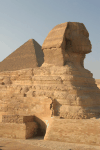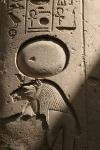A lot of the information on this page is from The Ancient Egypt Site (AES below), the site Ancient Egypt (AE below), and from Wikipedia. These sites have a lot of information and consistent time lines, although they differ. The hieroglyphic names are from both the AES and AE website. The times are all from the AE website.
From the Old Kingdom of Egypt entry in Wikipedia:
In ancient Egyptian history, the Old Kingdom is the period spanning c. 2700-2200 BCE. It is also known as the "Age of the Duos" or the "Age of the Pyramid Builders", as it encompasses the reigns of the great pyramid-builders of the 4th Dynasty, such as King Sneferu, who perfected the art of pyramid-building, and the kings Khufu, Khafre and Menkaure, who constructed the pyramids at Giza. Egypt attained its first sustained peak of civilization during the Old Kingdom, the first of three so-called "Kingdom" periods (followed by the Middle Kingdom and New Kingdom), which mark the high points of civilization in the lower Nile Valley.
The concept of an "Old Kingdom" as one of three "golden ages" was coined in 1845 by the German Egyptologist Baron von Bunsen, and its definition would evolve significantly throughout the 19th and the 20th centuries. Not only was the last king of the Early Dynastic Period related to the first two kings of the Old Kingdom, but the "capital", the royal residence, remained at In-Hedge, the Ancient Egyptian name for Memphis. The basic justification for a separation between the two periods is the revolutionary change in architecture accompanied by the effects on Egyptian society and the economy of large-scale building projects.
The Old Kingdom is most commonly regarded as the period from the 3rd Dynasty to the 6th Dynasty (2655 - 2176 BCE). Information from the 4th to the 6th Dynasties of Egypt is scarce, and historians regard the history of the era as literally "written in stone" and largely architectural in that it is through the monuments and their inscriptions that scholars have been able to construct a history. Egyptologists also include the Memphite 7th and 8th Dynasties in the Old Kingdom as a continuation of the administration, centralized at Memphis. While the Old Kingdom was a period of internal security and prosperity, it was followed by a period of disunity and relative cultural decline referred to by Egyptologists as the First Intermediate Period. During the Old Kingdom, the King of Egypt (not called the Pharaoh until the New Kingdom) became a living god who ruled absolutely and could demand the services and wealth of his subjects.
Under King Djoser, the first king of the 3rd Dynasty of the Old Kingdom, the royal capital of Egypt was moved to Memphis, where Djoser established his court. A new era of building was initiated at Saqqara under his reign. King Djoser's architect, Imhotep, is credited with the development of building with stone and with the conception of the new architectural form, the step pyramid. The Old Kingdom is perhaps best known for a large number of pyramids constructed at this time as burial places for Egypt's kings.
The first King of the Old Kingdom was Djoser (sometime between 2709 and 2690 BCE) of the Third Dynasty, who ordered the construction of a pyramid (the Step Pyramid) in Memphis' necropolis, Saqqara. An important person during the reign of Djoser was his vizier, Imhotep.
It was in this era that formerly independent ancient Egyptian states became known as nomes, under the rule of the king. The former rulers were forced to assume the role of governors or otherwise work in tax collection. Egyptians in this era worshiped their Pharaoh as a god, believing that he ensured the annual flooding of the Nile that was necessary for their crops. Egyptian views on the nature of time during this period held that the universe worked in cycles, and the Pharaoh on earth worked to ensure the stability of those cycles. They also perceived themselves as specially selected people.
The Old Kingdom and its royal power reached a zenith under the Fourth Dynasty (2655 - 2484 BCE), which began with Sneferu (2655 - 2607 BCE). After Djoser, Pharaoh Sneferu was the next great pyramid builder. Sneferu commissioned the building of not one, but three pyramids. The first is called the Meidum Pyramid, named for its location in Egypt. Sneferu abandoned it after the outside casing fell off of the pyramid. The Meidum pyramid was the first to have an above-ground burial chamber. Using more stones than any other Pharaoh, he built the three pyramids: a now collapsed pyramid in Meidum, the Bent Pyramid at Dahshur,and the Red Pyramid, at North Dahshur. However, the full development of the pyramid style of building was reached not at Saqqara, but during the building of "The Great Pyramids" at Giza.
Sneferu was succeeded by his son, Khufu (2607 - 2573 BCE), who built the Great Pyramid of Giza. After Khufu's death, his sons Djedefre (2573 - 2565 BCE) and Khafre (2565 - 2525 BCE) may have quarrelled. The latter built the second pyramid and (in traditional thinking) the Great Sphinx of Giza. Recent re-examination of evidence has led Egyptologist Vassil Dobrev to propose that the Sphinx had been built by Djedefra as a monument to his father Khufu. Alternatively, the Sphinx has been proposed to be the work of Khafre and Khufu himself.
There were military expeditions into Canaan and Nubia, with Egyptian influence reaching up the Nile into what is today Sudan. The later kings of the Fourth Dynasty were king Menkaure (2521 - 2493 BCE), who built the smallest pyramid in Giza, Shepseskaf (2493 - 2486 BCE) and, perhaps, Djedefptah (2486 - 2484 BCE).
The Fifth Dynasty (2484 - 2336 BCE) began with Userkaf (2484 - 2477 BCE) and was marked by the growing importance of the cult of sun god Ra. Consequently, fewer efforts were devoted to the construction of pyramid complexes than during the Fourth Dynasty and more to the construction of sun temples in Abusir. Userkaf was succeeded by his son Sahure (2477 - 2463 BCE), who commanded an expedition to Punt. Sahure was in turn succeeded by Neferirkare Kakai (2463 - 2453 BCE), who was Sahure's son. Neferirkare introduced the prenomen in the royal titulary. He was followed by two short-lived kings, his son Neferefre (2446 - 2443 BCE) and Shepseskare, the latter of uncertain parentage. Shepseskare may have been deposed by Neferefre's brother Nyuserre Ini (2443 - 2418 BCE), a long-lived pharaoh who built extensively in Abusir and restarted royal activity in Giza.
The last pharaohs of the dynasty were Menkauhor Kaiu (2418 - 2410 BCE), Djedkare Isesi (2410 - 2366 BCE), and Unas (2366 - 2336 BCE), the earliest ruler to have the Pyramid Texts inscribed in his pyramid.
Egypt's expanding interests in trade goods such as ebony, incense such as myrrh and frankincense, gold, copper, and other useful metals inspired the ancient Egyptians to build suitable ships for navigation of the open sea. They traded with Lebanon for cedar and travelled the length of the Red Sea to the Kingdom of Punt—possibly modern-day Somalia—for ebony, ivory, and aromatic resins. Shipbuilders of that era did not use pegs (treenails) or metal fasteners, but relied on the rope to keep their ships assembled. Planks and the superstructure were tightly tied and bound together.
During the Sixth Dynasty (2323 - 2176 BCE) the power of pharaoh gradually weakened in favor of powerful nomarchs (regional governors). These no longer belonged to the royal family and their charge became hereditary, thus creating local dynasties largely independent from the central authority of the Pharaoh. However, Nile flood control was still the subject of very large works, including especially the canal to Lake Moeris around 2300 BCE, which was likely also the source of water to the Giza pyramid complex centuries earlier.
Internal disorders set in during the incredibly long reign of Pepi II (2249 - 2185 BCE) towards the end of the dynasty. His death, certainly well past that of his intended heirs, might have created succession struggles. The country slipped into civil wars mere decades after the close of Pepi II's reign.
The final blow was the 22nd century BCE drought in the region that resulted in a drastic drop in precipitation. For at least some years between 2200 and 2150 BCE, this prevented the normal flooding of the Nile.
Whatever its cause, the collapse of the Old Kingdom was followed by decades of famine and strife. An important inscription on the tomb of Ankhtifi, a nomarch during the early First Intermediate Period, describes the pitiful state of the country when famine stalked the land.
Following is the list of Egyptian Pharaohs as well as I could determine it:
All pictures are © Dr. Günther Eichhorn, unless otherwise noted.
| Name of Pharaoh | Dates | Birth Name | Coronation Name | Horus Name | Comment |
|---|---|---|---|---|---|
| (from The Ancient Egypt Site and Ancient Egypt) | |||||
Old Kingdom (AES Wiki ) | 2727 - 2176 BCE | ||||
3rd Dynasty (AES Wiki AE) | 2727 - 2655 BCE | ||||
| Sanakhte (AES Wiki) | 2727 - 2709 BCE | n/a | |||
| Djoser (Netjerikhet) (AES Wiki) | 2709 - 2690 BCE | n/a | Built Step Pyramid | ||
| Sekhemkhet (AES Wiki) | 2690 - 2684 BCE | n/a | |||
| Khaba (AES Wiki) | 2684 - 2679 BCE | n/a | |||
| Huni (AES Wiki) | 2679 - 2655 BCE | n/a | n/a | ||
4th Dynasty (AES Wiki AE) | 2655 - 2484 BCE | ||||
| Snofru (AES Wiki) | 2655 - 2607 BCE | n/a | Built Bent Pyramid and Red Pyramid | ||
| Khufu (Cheops) (AES Wiki) | 2607 - 2573 BCE | Built the Great Pyramid | |||
| Djedefre (AES Wiki) | 2573 - 2565 BCE | ||||
| Khafre (Chephren) (AES Wiki) | 2565 - 2525 BCE | Built second largest pyramid | |||
| Bakare (AES Wiki) | 2525 - 2521 BCE | n/a | n/a | ||
| Menkaure (Mycerinus) (AES Wiki) | 2521 - 2493 BCE | Built third largest pyramid | |||
| Shepseskaf (AES Wiki) | 2493 - 2486 BCE | ||||
| Thamphthis/Djedefptah (Wiki) | 2486 - 2484 BCE | n/a | n/a | n/a | |
5th Dynasty (AES Wiki AE) | 2484 - 2336 BCE | ||||
| Userkaf (AES Wiki) | 2484 - 2477 BCE | ||||
| Sahure (AES Wiki) | 2477 - 2463 BCE | n/a | |||
| Neferirkare I Kakai (AES Wiki) | 2463 - 2453 BCE | ||||
| Shepseskare Isi (AES Wiki) | 2453 - 2446 BCE | ||||
| Neferefre (AES Wiki) | 2446 - 2443 BCE | ||||
| Niuserre Ini (AES Wiki) | 2443 - 2418 BCE | ||||
| Menkauhor Kaiu (AES Wiki) | 2418 - 2410 BCE | ||||
| Djedkare Isesi (AES Wiki) | 2410 - 2366 BCE | ||||
| Unas (AES Wiki) | 2366 - 2336 BCE | n/a | |||
6th Dynasty (AES Wiki AE) | 2323 - 2176 BCE | ||||
| Teti (AES Wiki) | 2336 - 2306 BCE | n/a | |||
| Userkare (AES Wiki) | 2306 - 2303 BCE | n/a | n/a | ||
| Pepi I Meryre (AES Wiki) | 2306 - 2256 BCE | ||||
| Merenre I (Nemtiemsaf I) (AES Wiki) | 2256 - 2249 BCE | ||||
| Pepi II Neferkare (AES Wiki) | 2249 - 2185 BCE | ||||
| Merenre II (Nemtiemsaf II) (AES Wiki) | 2185 - 2184 BCE | n/a | |||
| Nitocris (Wiki) | 2184 - 2183 BCE | n/a | n/a | First of the female Pharaohs | |
| Neferka (the child) | 2183 - 2182 BCE | n/a | n/a | ||
| Nefer | 2182 - 2181 BCE | n/a | n/a | ||
| Ibi | 2181 - 2176 BCE | n/a | n/a | ||
|
|
|
First Intermediate Period
|
Here are the links to the other pages on Egypt:






Page last updated on Sun Jun 5 14:17:33 2022 (Mountain Standard Time)
Page last updated on Tue Apr 23 10:19:22 2024 (Mountain Standard Time)
Egypt - Pharaohs of the Old Kingdom - 2655 - 2176 BCE on soaring.guenther-eichhorn.com